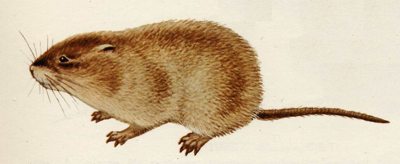Pests
Arvicola terrestris (Linnaeus, 1758). - European water vole (Water vole)
Taxonomic position.
The class Mammalia, order Rodentia, family Cricetidae, subfamily Microtinae, genus Arvicola. Considerable geographic variability: more than 30 subspecies are described, and some of them (A.sapidus, A.amphibius, A.scherman) are considered independent species in recent scientific literature. The fauna of the former USSR includes up to 16 subspecies.Biological group.
Rodent pests.Morphology and biology.
The largest of voles. The body size is greatly variable both in different parts of area, and in different landscapes within one geographic zone. Average length of body, 140 to 215 mm; weight of body, 120 to 330 g. The tail is round, covered with sparse hairs, on the average equal to 1/2 to 2/3 length of body. Incisors yellow brown. The coloration of dorsal fur varies greatly from grey or brownish to dark-brown and black tints. The ventrum of body is usually lighter than the back. Diploid set of chromosome, 36. The mode of life is intimately connected to fresh reservoirs; the species lives on flood-lands at rivers, in waterlogged terrains, and along banks of reservoirs; swims and dives well. In mountainous terrains it reaches alpine meadows.Distribution.
Northern part of the Eurasian continent from the Atlantic coast of western Europe to central and southeastern Yakutiya; in the South, to northern coast of the Mediterranean sea, to Minor Asia, the Middle East, northern Mongolia, northwestern regions of China. In the former USSR, the entire European part (except the extreme North), Kazakhstan (except desert and semidesert regions), Siberia (except the Arctic zone).Ecology.
A seasonal change of habitats and mode of life during the year is characteristic of the species, from near-water life in summer to semi-underground life with intensive digging activity in autumn-winter season. Feeding includes mainly juicy parts of plants. For winter it makes reserves of forage. Reproduction during the warm season; from 4 to 6 broods; on the average 6 to 8 young voles in a brood. The flashes of mass outbreaks with thousandfold excess of initial level of numbers are observed some years.Economic significance.
Causes essential damage to all field crops on flood-lands of rivers and at a short distance from reservoirs; also causes damage in pastures and hayfields, in orchards and nurseries, vegetable gardens and storages of agricultural production. There is a steady zone of high damage during episodes of flashes of mass reproduction in Western Siberia (Novosibirsk, Omsk, and Tyumen Regions). Has minor commercial value. A major vector of tularemia, Omsk hemorrhagic fever, leptospirosis and other transmissible diseases. Control measures include baits and mechanical (cylinder traps, snares) elimination.Reference citations:
Formozov A.N. 1947. An essay of ecology of the rodents - vectors of tularemia. Materialy po gryzunam (Materials on rodents). Vol. 1., pp. 13-44 (in Russian).Kuzyakin A.P. (Ed.). 1959. Water vole and its control in Western Siberia. Novosibirsk: Knizhnoe Izd. 478pp. (in Russian).
Panteleev P.A. 1968. A population ecology of water vole and control measures. Moscow: Nauka. 255pp. (in Russian).
Panteleev P.A. (Ed.). 2001. The Water vole: an image of the species. Moscow: Nauka. 527pp. (in Russian).


